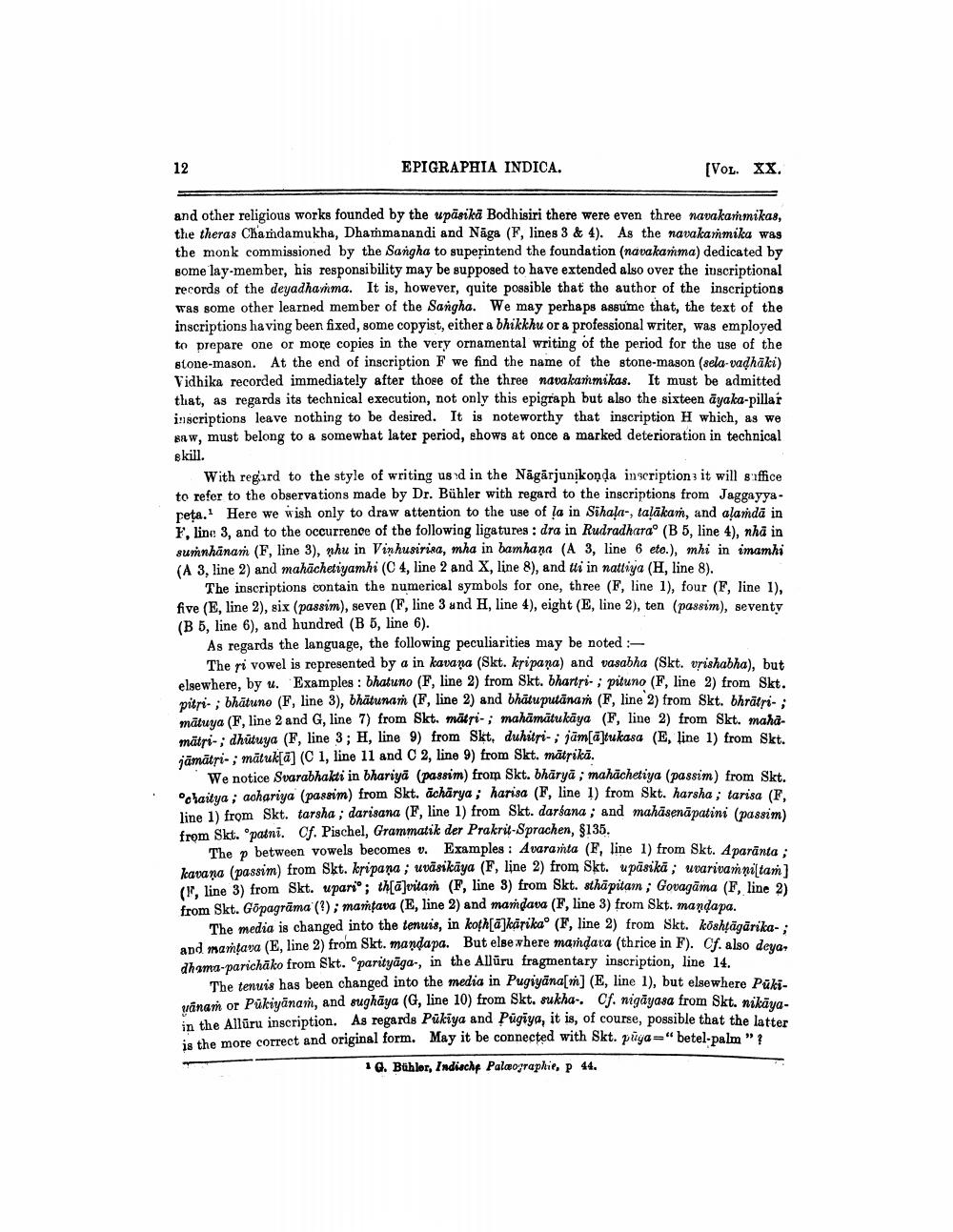________________
12
EPIGRAPHIA INDICA.
(VOL. xx.
and other religious works founded by the upāsikā Bodhisiri there were even three navakaṁmikas, the theras Chardamukha, Dhammanandi and Nāga (F, lines 3 & 4). As the navakanmika was the monk commissioned by the Sangha to superintend the foundation (navakaṁma) dedicated by some lay-member, his responsibility may be supposed to have extended also over the inscriptional records of the deyadharima. It is, however, quite possible that the author of the inscriptions was some other learned member of the Sangha. We may perhaps assume that, the text of the inscriptions having been fixed, some copyist, either a bhikkhu or a professional writer, was employed to prepare one or more copies in the very ornamental writing of the period for the use of the stone-mason. At the end of inscription F we find the name of the stone-mason (sela-vadhāki) Vidhika recorded immediately after thoee of the three navakaṁmikas. It must be admitted that, as regards its technical execution, not only this epigraph but also the sixteen āyaka-pillar il scriptions leave nothing to be desired. It is noteworthy that inscription H which, as we Baw, must belong to a somewhat later period, shows at once a marked deterioration in technical skill.
With regard to the style of writing usd in the Nägärjunikonda inscriptions it will suffice to refer to the observations made by Dr. Bühler with regard to the inscriptions from Jaggayyareta. Here we wish only to draw attention to the use of ļa in Sihala-, taļākam, and alanda in F, line 3, and to the occurrence of the following ligatures : dra in Rudradharao (B 5, line 4), nhà in suņnhānam (F, line 3), nhu in Vinhusirina, mha in bamhana (A 3, line 6 eto.), mhi in imamhi (A 3, line 2) and mahächetiyamhi (C 4, line 2 and X, line 8), and ui in nattija (Hline 8).
The inscriptions contain the numerical symbols for one, three (F, line 1), four (F, line 1). five (E, line 2), six (passim), seven (F, line 3 und H, line 4), eight (E, line 2), ten (passim), seventy (B 5, line 6), and hundred (B 5, line 6).
As regards the language, the following peculiarities may be noted :
The ri vowel is represented by a in kavana (Skt. kripana) and vasabha (Skt. vrishabha), but elsewhere, by u. Examples : bhatuno (F, line 2) from Skt. bhartri- ; pituno (F, line 2) from Skt. pitri- ; bhätuno (F, line 3), bhätunan (F, line 2) and bhätuputānam (F, line 2) from Skt. bhrätri- : mātuya (F, line 2 and G, line 7) from Skt. mätri-; mahämätukāya (F, line 2) from Skt. mahamätri- ; dhūtuya (F, line 3; H, line 9) from Skt. duhitri-, jäm[@]tukasa (E, line 1) from Skt. jāmātri-, mātuk[a] (C 1, line 11 and C 2, line 9) from Skt. mätrikā.
We notice Svarabhakti in bhariya (passim) from Skt. bhāryā , mahächetiya (passim) from Skt. "chaitya , achariya (passim) from Skt. ācharya , harisa (F, line 1) from Skt. harsha, tarisa (F. line 1) from Skt. tarsha, darisana (F, line 1) from Skt. darśana ; and mahäsenapatini (passim) from Skt. opatni. Cf. Pischel, Grammatik der Prakrit-Sprachen, $135.
They between vowels becomes v. Examples : Avarata (F, line 1) from Skt. Aparänta : kavana (passim) from Skt. kripana ; uvāsikäya (F, line 2) from Skt. upasika; uvarivammiltal (1. line 3) from Skt. upario; th[ävitam (F, line 3) from Skt. sthāpitam; Govagāma (F. line 21 from Skt. Göpagrāma(); mamava (E, line 2) and mandava (F, line 3) from Skt. mandapa.
The media is changed into the tenuis, in koth[ā]kārikao (F, line 2) from Skt. köshägārikaand mamtava (E, line 2) from Skt. mandapa. But else where mandara (thrice in F). Cf. also deva. dhama-parichāko from Skt. oparityāga-, in the Allūru fragmentary inscription, line 14.
The tenuis has been changed into the media in Pugiyana[m] (E, line 1), but elsewhere Pūkivanam or puliyanan, and sughāya (G, line 10) from Skt. sukha. Cf. nigāyasa from Skt. nikāva. in the Allūru inscription. As regards Pūkiya and Pügiya, it is, of course, possible that the latter is the more correct and original form. May it be connected with Skt. pūya="betel-palm"?
16. Bühler, Indische Palæographie, p 44.




